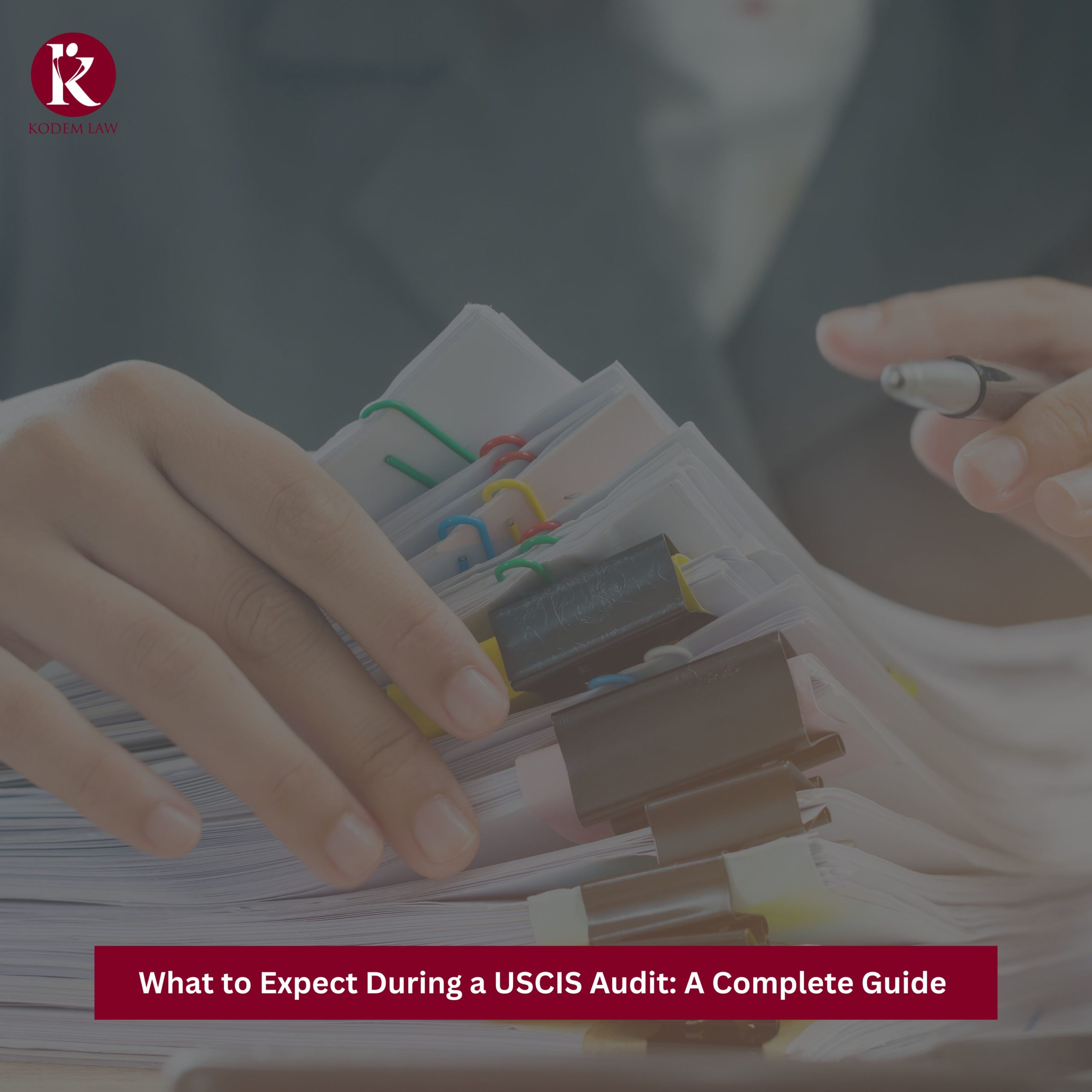
A USCIS audit is a crucial process for verifying compliance with immigration regulations. Understanding what to expect during an audit can help you prepare effectively, ensuring a smoother experience and better outcomes.
This guide provides a comprehensive overview of USCIS audits, including preparation, the audit process, and how to respond.
Understanding a USCIS Audit
A USCIS audit is a review conducted by U.S. Citizenship and Immigration Services to ensure compliance with immigration laws and regulations. The purpose is to verify that immigration petitions and records are accurate and that the entities involved, such as employers and applicants, adhere to the legal requirements.
Types of Audits Conducted by USCIS
USCIS may perform several types of audits, including:
- Employer Audits: Focused on verifying employer compliance with visa regulations.
- Site Visits: Assessing the accuracy of claims made in petitions or applications.
- Random Checks: Conducted to ensure overall compliance and deter fraud.
Reasons for a USCIS Audit
Audits can be triggered by various factors, such as:
- Irregularities: Discrepancies or inconsistencies in submitted documents.
- Random Checks: Routine inspections to ensure compliance.
- Employer Compliance Issues: Concerns about an employer’s adherence to immigration laws.
Importance of Document Organization and Accuracy
Proper documentation is critical. Inaccurate or disorganized records can lead to complications. Ensuring that all paperwork is correct and easily accessible helps facilitate a smoother audit process:
- Facilitates Efficient Review: Well-organized documents allow auditors to quickly access and review information, reducing the time spent searching for necessary files.
- Reduces Errors: Accurate and up-to-date records minimize the risk of errors or discrepancies that could lead to complications or denials during the audit.
- Enhances Credibility: Properly organized and precise documentation demonstrates professionalism and compliance, enhancing the credibility of your case.
- Prevents Delays: Ensuring that all documents are accurate and systematically arranged helps avoid delays in the audit process and potential follow-up requests.
- Supports Effective Response: Organized files and accurate records enable a swift and effective response to any auditor inquiries or issues that arise.
- Mitigates Legal Risks: Accurate documentation ensures adherence to legal requirements, reducing the risk of non-compliance penalties or legal complications.
Preparing for a USCIS Audit
Preparing for a USCIS audit is crucial for ensuring a smooth and successful review process. Here are key steps to take before the audit:
- Review Audit Notice: Carefully read the audit notice to understand the scope and requirements.
- Gather Documentation: Collect all relevant documents, including visa petitions, supporting evidence, and compliance records.
- Organize Files: Arrange documents systematically, ensuring they are easy to access and review.
- Verify Accuracy: Check that all documents are accurate, up-to-date, and reflect the current status of your case.
- Identify Key Areas: Focus on areas highlighted in the audit notice and ensure all related documentation is complete.
- Consult with Legal Counsel: Seek advice from an immigration attorney to review documentation and ensure compliance with legal requirements.
- Prepare for Interviews: Be ready to provide explanations and answer questions related to your documentation and processes.
- Conduct Internal Review: Perform a self-audit to identify and address any potential issues before the official audit.
- Train Staff: Ensure that all relevant personnel are aware of the audit process and know how to handle inquiries.
Importance of Document Organization and Accuracy
- Facilitates Quick Access: Well-organized documents allow for efficient retrieval and review during the audit.
- Ensures Compliance: Accurate documentation helps demonstrate adherence to USCIS requirements and reduces the risk of non-compliance.
- Prevents Errors: Accurate records minimize the likelihood of mistakes that could negatively impact the audit outcome.
- Enhances Credibility: Properly organized and accurate documents strengthen your position and build credibility with auditors.
- Reduces Stress: Being well-prepared with organized and accurate documentation helps alleviate stress during the audit process.
The Audit Process: What Happens During a USCIS Audit and How USCIS Auditors Conduct Their Reviews?
What Happens During a USCIS Audit:
During a USCIS audit, several key steps and procedures unfold to ensure compliance with immigration regulations:
1. Notification and Scheduling: USCIS initiates the process by sending an audit notice that details the scope, purpose, and required documentation. This notice outlines the specific records and time periods the auditors will review. Following this, a date is scheduled for the audit, and the audited entity must prepare all necessary documents accordingly.
2. Document Submission: The first stage of the audit involves submitting requested documents, such as visa petitions, supporting evidence, and compliance records. This may include I-9 forms, payroll records, and other pertinent paperwork. Auditors might request additional documentation or clarification during their review.
3. On-Site Review (if applicable): USCIS auditors may visit the workplace to review physical records, verify employee status, and ensure compliance with visa conditions. They may also conduct interviews with employees or company representatives to verify the accuracy of the information provided and gather additional details.
4. Review and Analysis: Auditors meticulously examine all submitted and collected documents to ensure they align with USCIS regulations and guidelines. The review focuses on whether the entity complies with visa and employment requirements, including verifying that job roles and conditions match the details provided in the petitions.
5. Findings and Report: After the review, auditors prepare a report that outlines their findings. This report may highlight compliance issues, discrepancies, or areas requiring improvement. It might also include recommendations for corrective actions if any non-compliance or issues are identified.
6. Follow-Up Actions: Following the audit, there is a response period during which you may address any discrepancies or provide additional information as required. USCIS will then make a final determination based on the audit report and your response,which could lead to continued compliance, further review, or potential penalties.
Note: Understanding these steps and how USCIS auditors conduct their reviews can help you prepare effectively, ensuring a smoother audit process and improving your chances of a favourable outcome.
How USCIS Auditors Conduct Their Reviews:
- Preparation and Planning: Define the audit scope based on the notice and use a checklist to ensure all necessary documents and areas are covered.
- Document Review: Examine submitted documents for accuracy, completeness, and compliance, and cross-check information to identify discrepancies.
- Interviews and Site Visits: Conduct interviews with employees and perform site inspections to verify alignment between workplace conditions and visa petition details.
- Analysis and Reporting: Assess compliance with immigration and employment laws, and prepare a report with findings, areas of compliance and non-compliance, and recommendations for improvement.
Note: By understanding the USCIS audit process and how auditors conduct their reviews, you can better prepare for and manage the audit, ensuring a smoother and more successful outcome.
Common Issues Found During USCIS Audits
- Documentation Errors: Missing, incomplete, or inaccurate documents are frequent issues. To address this, review and update all documents to ensure they are complete and accurate.
- Procedural Lapses: Failure to follow USCIS procedures or guidelines can be problematic. Ensure strict adherence to all USCIS procedures to prevent lapses.
- Inconsistent Information: Discrepancies between forms, documents, and statements can lead to complications. Align all forms and documents to ensure consistency and accuracy.
- Compliance Issues: Non-compliance with visa requirements or regulations is a major concern. Rectify any non-compliance by aligning practices with USCIS regulations and requirements.
- Record-Keeping Issues: Poorly organized or inadequate records can hinder the audit process. Improve record-keeping by systematically organizing and maintaining thorough documentation.
How to Respond to an Audit Notice
Steps to Take Upon Receiving an Audit Notice:
- Review the Notice: Understand the scope and specific issues raised in the notice.
- Gather Documentation: Collect all relevant documents and records requested by USCIS.
- Prepare a Response: Draft a comprehensive response addressing the concerns and providing necessary documentation.
- Consult with Experts: Seek guidance from legal or compliance professionals if needed.
Key Components of a Proper Response:
- Detailed Explanation: Address each issue raised in the audit notice with clear explanations and supporting documentation.
- Corrective Actions: Outline steps taken to rectify any identified issues.
- Compliance Confirmation: Demonstrate adherence to USCIS regulations and procedures.
Legal and Compliance Considerations
Legal Obligations During an Audit:
- Provide Accurate Information: Ensure all information provided is truthful and complete.
- Cooperate with Auditors: Comply with requests and deadlines set by USCIS.
- Follow Regulations: Adhere to all applicable USCIS rules and guidelines.
How to Ensure Compliance with USCIS Regulations:
- Regular Reviews: Conduct periodic internal audits to ensure ongoing compliance.
- Update Procedures: Stay informed about regulatory changes and update procedures accordingly.
- Training: Train staff on compliance and audit preparation.
Potential Outcomes of a USCIS Audit
1. Possible Results of an Audit:
- Approval: Confirmation of compliance and no further action required.
- Denial: Rejection of the application or petition, often requiring a re-application or appeal.
- Additional Scrutiny: Further review or follow-up requests for additional information.
2. Next Steps Depending on the Outcome:
- Approval: Continue to adhere to USCIS requirements and monitor for any future audits.
- Denial: Address reasons for denial and consider options for appeal or re-application.
- Additional Scrutiny: Provide requested information promptly and address any additional concerns.
3. Tips for a Successful Audit
- Prepare Thoroughly: Review all requested documents and ensure accuracy before submission.
- Communicate Clearly: Provide clear and comprehensive responses to all audit inquiries.
- Document Everything: Keep meticulous records of all interactions and submissions related to the audit.
Common Mistakes to Avoid
- Ignoring Deadlines: Missing deadlines for responses or submissions can negatively impact the audit outcome.
- Inconsistent Information: Providing conflicting information across documents or responses can lead to complications.
- Inadequate Documentation: Failing to include necessary supporting documents can hinder your case.
How can Kodem Law Help You?
When facing complex audit issues, past audit problems, or uncertainties in responding to audit notices, Kodem Law offers expert legal assistance. Our attorneys provide specialized advice, ensure compliant responses, and help mitigate risks. To select the right attorney, verify their experience in immigration and USCIS audits, review client feedback, and consult multiple attorneys to compare expertise and fees.

